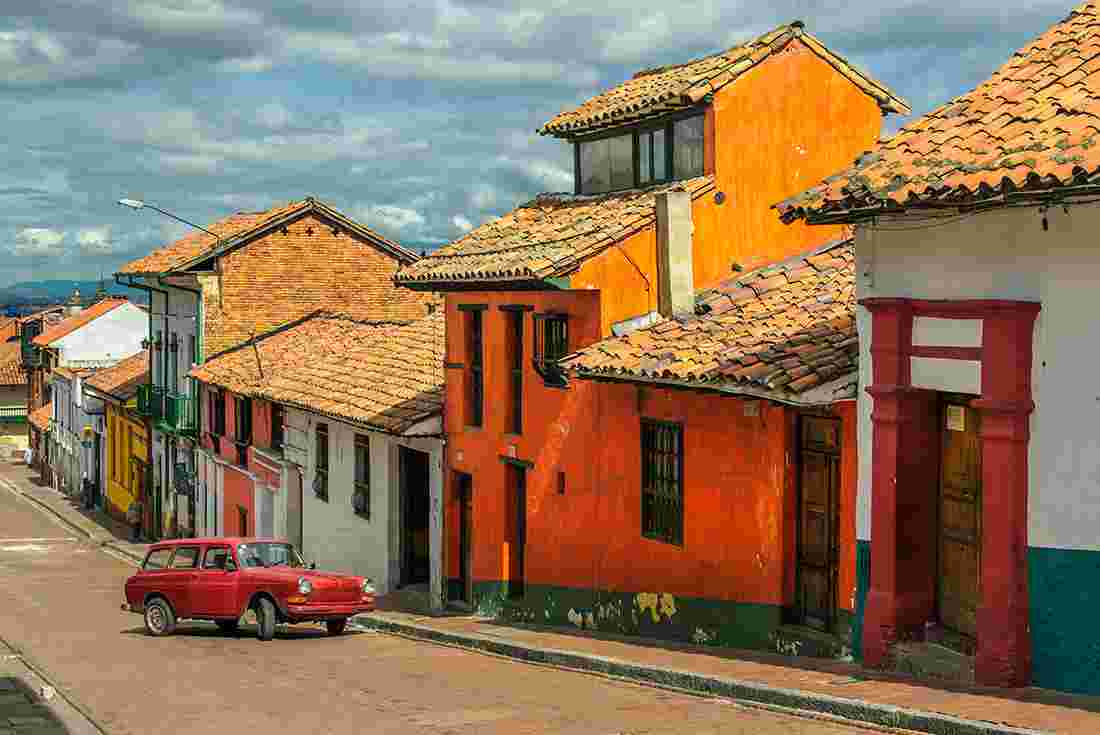Colombia - Affordable Dentistry

Country Profile
Colombia is a country situated in the northwest of South America, bordered to the northwest by Panama; to the east by Venezuela and Brazil; to the south by Ecuador and Peru; and it shares maritime limits with Costa Rica, Nicaragua, Honduras, Jamaica, Dominican Republic and Haiti.
The territory of what is now Colombia was originally inhabited by indigenous peoples including the Muisca, Quimbaya, and Tairona. Colombia is ethnically diverse, its people descending from the original native inhabitants, Spanish colonists, Africans originally brought to the country as slaves, and 20th-century immigrants from Europe and the Middle East, all contributing to a diverse cultural heritage. This has also been influenced by Colombia's varied geography, and the imposing landscape of the country has resulted in the development of very strong regional identities. The majority of the urban centres are located in the highlands of the Andes mountains, but Colombian territory also encompasses Amazon rainforest, tropical grassland and both Caribbean and Pacific coastlines.
Ecologically, Colombia is considered one of the world's 17 megadiverse countries, and of these, the most biodiverse per square kilometer. Colombia has a diversified economy with macroeconomic stability and favorable growth prospects in the long run.
National Demographic
With an estimated 48 million people in 2015, Colombia is the third-most populous country in Latin America, after Brazil and Mexico. It is also home to the third-largest number of Spanish speakers in the world after Mexico and the United States.
Race and ethnicity in Colombia descends mainly from three racial groups—Amerindians, blacks, and whites—that have mingled throughout the last 500 years of the country's history. Some demographers describe Colombia as one of the most ethnically diverse countries in the Western Hemisphere and in the World, with 85 different ethnic groups. Most Colombians identify themselves and others according to ancestry, physical appearance, and sociocultural status. Social relations reflect the importance attached to certain characteristics associated with a given racial group.
Telecommunications
The Colombian telecommunications sector has added new services, expanded coverage, improved efficiency, and lowered costs. The sector has had the second largest (after energy) investment in infrastructure (54%) since 1997. In June 2003, the government liquidated the state-owned and heavily indebted National Telecommunications Company (Empresa Nacional de Telecomunicaciones—Telecom) and replaced it with Colombia Telecomunicaciones (Colombia Telecom). The measure enabled the industry to expand rapidly, and in 2004 it constituted 2.8% of gross domestic product (GDP). Telefónica of Spain acquired 50% plus one share of the company in 2006. As a result of increasing competition, Colombia has a relatively modern telecommunications infrastructure that primarily serves larger towns and cities. Colombia’s telecommunication system includes INTELSAT, 11 domestic satellite Earth stations, and a nationwide microwave radio relay system.
Colombia’s mobile market is one of the fastest-growing businesses in the country. In mid-2004 mobile telephones overtook fixed lines in service for the first time. By 2005 Colombia had the highest mobile phone density (90%) in Latin America, as compared with the region’s average density of 70%. The number of mobile telephone subscribers totaled an estimated 31 million in 2007, as compared to 21.8 million in 2005 and 6.8 million in 2001.
English Literacy
More than 99.2% of Colombians speak Spanish, also called Castilian; 65 Amerindian languages, two Creole languages, the Romani language and Colombian Sign Language are also spoken in the country. English has official status in the archipelago of San Andrés, Providencia and Santa Catalina.
School System
Education in Colombia includes nursery school, elementary school, high school, technical instruction and university education.
Primary Education - Due to a national shortage of education facilities the Colombian government has adopted an automatic promotion policy. Despite this, many Colombians compare their standards favorably with those of America. From age 1 onwards children are seen in community daycare and nursery schools sponsored by the National Institute for Family Welfare. At age 6 they enroll at elementary school. Standards in rural areas compare badly with city ones where teachers are far better qualified.
Secondary education is divided to 4 years of compulsory basic secondary education, grades 6 to 9, and 2-year non-compulsory stage known as Middle Vocational Education (Educacion Media Vocacional), grades 10 and 11. Vocational Education offers different specializations (technical, business, arts, and others, including purely academic programs), and mostly available in urban areas.
Tertiary Education - The Colombian higher education system comprises technical institutes, and technological and academic universities. Most of these align with government programs with the exception of those with church affiliations. Academic strata include undergraduate degrees, graduate programs, masters degrees and doctorates.
Sadly, access to tertiary education currently remains restricted to the sons and daughters of wealthy city dwellers. Until this changes, a tertiary education remains a dream for children trapped in rural squalor.
Further Education
Education for Employment and Human Development is regulated by law 1064 of 2006 and the 2888 decree of 2007. It provides a degree of technical education: skills and talents to improve the level of subsistence. Education for employment involves technical skills for work through the formation of "labor competences", which is a Colombian strategy to standardize and certify human resource, expanding and diversify the formation and training of human resources. It includes the education provided by the enterprises to their employees. The Colombian government promotes this kind of education as an alternative to university education, which is not accessible for the majority. Some institutions that provide this services are SENA (national service of learning), CESDE, ANDAP, and INCAP among others.
Dental Education
All applicants to dental school must have graduated from high school; no undergraduate pre-dental coursework is required before admission. Dental school admission in Colombia requires successful completion of the Instituto Colombiano para el Fomento de la Educacion Superior (ICFES) test, as well as a test administered by the dental school. The ICFES test assesses knowledge of subjects taught in high school; some dental schools award scholarships to the applicants with the highest scores on the ICFES test. If the submitted scores and high school course work are satisfactory, the applicant will be contacted for an interview. Tuition for public dental schools is less expensive than that of private dental schools.
The Ministry of Health and Social Protection and the Colombian Dental Association have been working together to promote science-based education and a standardized curriculum; however, most schools do not use the same curriculum. All schools conduct classes mainly in Spanish. The 5-year dental school program culminates in a Doctor of Dental Surgery (D.D.S.) degree. It comprises 2 years, or 4 semesters, of mainly pre-clinical didactic and laboratory courses, and 3 years, or 6 semesters, of mainly clinical training that is supervised by faculty members. The third year of the course, i.e., the fifth and sixth semesters, includes lectures, seminars, and introductions to clinical dentistry, as well as initial work on student projects. In the fourth year (the seventh and eighth semesters), students continue with clinical activities, projects, and lectures. In the fifth year (the ninth and tenth semesters), students take rotations in some hospitals and health institutions, including some outside Colombia.
Due to socioeconomic issues in Colombia, UNICOC has created a new 4-year, 8-semester, curriculum. With this short program, dental students are able to go back to their hometown sooner, thereby hastening the development of the dental health care system and public health infrastructure in small towns.
There are several postgraduate programs available; these are oriented to clinical dentistry and are of varying duration. After successful completion of a postgraduate program, a candidate is eligible for a 2-year master's degree program.
The Dentistry Profession
Colombia does not have national or state dental licensure examinations like the US National and State Board Dental Examinations. In addition, continuing education courses are currently not compulsory; however, there are plans to introduce mandatory continuing dental education requirements. To qualify as a practicing dentist, Colombia requires a D.D.S degree and 1 year of paid compulsory government service, during which graduates are assigned to locations by the Ministry of Health, although individual preferences are also taken into account. More than 90% of new graduates are assigned to work in public hospitals and in rural areas.
Getting There for Dental Care
Colombia has several airports but most international travelers will fly into Bogota or Cartagena. Avianca, the country’s national carrier, flies regularly from Miami and New York to Bogota. American, Continental and Delta also provide service between regional US air hubs and Bogota. Travelers from the UK can take British Airways direct to Colombia. Unfortunately, there are currently no direct flights from Canada or Australia. The airport is not a place you want to be wandering around, so make your transportation arrangements before you arrive. Your hotel can arrange a pick up or you can hire a taxi directly at the airport. These are the only two means of ground transfers available for arriving passengers. Cartagena’s Murcia–San Javier Airport (San Javier International Airport) (MJV) is the second most popular destination for overseas visitors. This busy and efficient terminal handles many international and domestic flights each day. It is a safer airport than Bogota, but you should still be careful when choosing your transportation into the city, the two most preferable options are hotels shuttle services and licensed taxis which can be found at arrivals.
Since bus travel is the most common form of transportation for Colombians, the coaches are comfortable and the services are generally good. The massive Terminal de Transportes, in the heart of Bogota, is where long-distance buses arrive and depart. You will find all the major bus companies here like TESPA buses connect Colombia with Venezuela and Ecuador every day.
Colombia only has road connections with Ecuador and Venezuela. They are well-traveled and shouldn’t present any problems crossing the border. However, driving anywhere in Colombia is not recommended. It’s much safer to simply fly between cities, take a tour bus or hire a driver. If you have to drive yourself, don’t travel at night.
With ports on both the Pacific and Caribbean coasts, it is possible to arrive by boat. The sea traffic is busier on the Caribbean side, as boats frequently come in from the US, Mexico and Central America. Colombian ports on the Caribbean coast include Cartagena, Santa Marta, Baranquilla and Turbo. Buenaventura is the main port city along the Pacific coast. Many cruise lines include a stop in Cartagena. For something more exciting, you can take a sailing boat from Panama through the San Blas Islands to Cartagena.
Visitor Highlights
The top tourist attractions in Colombia have just now started to develop into the mainstream. A country marred by its past is just now staring to climb outside its shell and shine on the world stage.
Everything that you can think of from the history of Cartagena, the world renown coffee plantations, and even the lovable city of Medellin leaves tourists wanting to come back for years. There are tour companies sprouting up in almost every city (every day) and the things to do in the once war torn country are growing rapidly.
An ideal destination for backpackers, Colombia has much to offer; whether you are looking for an affordable destination where you can make your money go further (and put off returning to that desk job), want to experience the amazing Amazon rainforest, while away the hours on a beautiful beach, or visit one of the thoroughly modern cities; there really is something for everyone. If you like your beaches to contain white sand, meet with crystal clear turquoise water and have snorkeling & scuba diving opportunities a plenty, then you’ve definitely come to the right place, as Colombia has some of the best beaches in South America. If you’re not a fan of beaches then here are my alternative places to visit like Medellin (often called “city of the eternal spring”), Amazon Rainforest, The historic centre of Cartagena, Lost City (Ciudad Perdida), and Mompox (officially Santa Cruz de Mompox) for its well-preserved colonial architecture. You can also visit The Colombian Tourism website to get more information.

